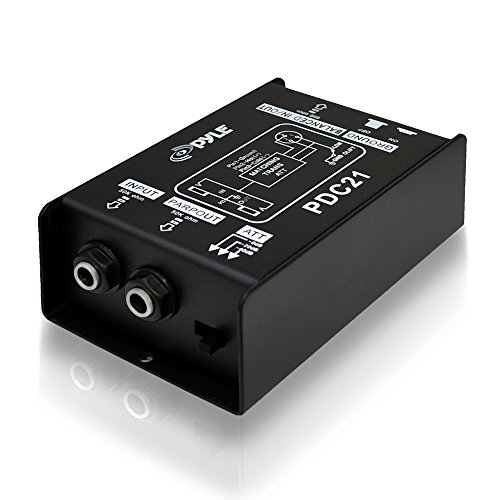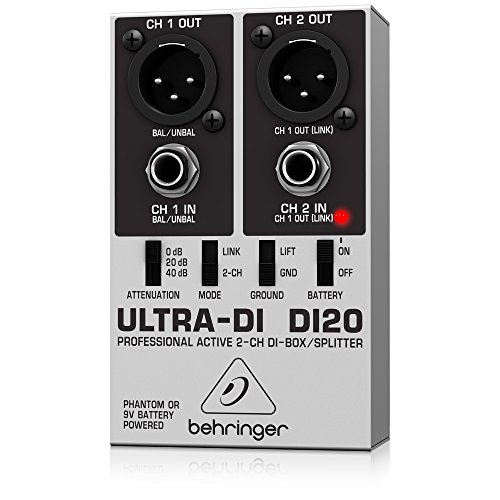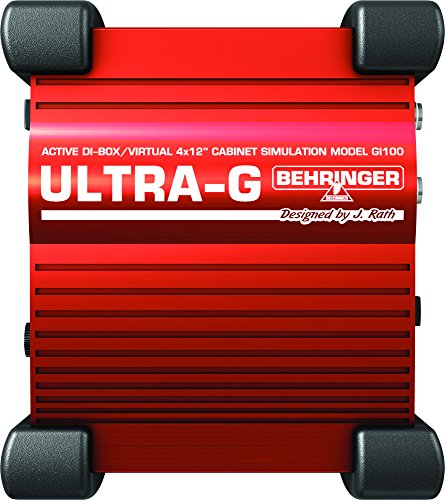Given that they can be a recording necessity, we are checking out a few direct injection options to solve your impedance issues, so join us as we investigate the 5 best DI boxes for bass in 2025.
Now you are going to notice we decided to focus on the Behringer range and there is a good reason for this as DI boxes for bass need to be able to match impedance without losing the signal integrity which is something not all DI boxes manage.
Table of Contents
Generally speaking, the signal loss is often in the low end which for bass is out of the question and whilst there are other options on the market we thought we would hone in on what sets some of Behringer's boxes apart and have included a separate brand for good comparative measure.
At a glance: Our top 3 picks

Behringer Ultra-DI DI400P

- Renowned Behringer OT-2 transformer.
- Rugged case.
- 3,000 Watt handling.

Behringer V-Tone Bass Driver

- Renowned Behringer OT-2 transformer.
- Rugged case.
- 3,000 Watt handling.

Premium Direct Injection Audio Box

- Renowned Behringer OT-2 transformer.
- Rugged case.
- 3,000 Watt handling.
View The Best DI Box For Bass Below
1. Behringer Ultra-DI DI400P
First off we have a passive DI box from Behringer, which features top-notch German engineering incorporating a proprietary OT-2 transformer.
The transformer is tuned to a flat frequency which lets it deliver greater signal fidelity. It offers highly effective signal isolation and has a ground-lift switch to ensure it maintains a clear and direct signal free of any hum.
The superior electronics are stashed inside a very heavy-duty case with a compact size. It has a simple user-friendly design and features gold-plated, 1/4” jacks for in and out with an XLR send which is brilliantly balanced. It can cope with power ratings of up to 3,000 Watts.
Pros:
+ Renowned Behringer OT-2 transformer.
+ Rugged case.
+ 3,000 Watt handling.
Why We Liked It - It is genuinely quiet and high-quality for such a reasonable retail price, it matches impedance to a T and provides a savvy solution.
Record a DI track - When making a live recording, you don't usually get a safety net, but that's what a DI recording can give you. Let's say you play your part, and everyone loves it, but on playback, there's a ridiculous hum that no one heard the first time around. Running a cable from your DI to your interface and your amp allows you to record a DI track as a backup.

2. Behringer V-Tone Bass Driver
This next option is pretty much a 2 for 1 as it is a great modeling pre-amp with some fantastic vintage tones on-board as well as an integrated DI which matches the impedance of your output desk.
The tube-emulation is pretty impressive and gives bassists a range of sounds to play with which are fat and authentically modeled. It features DRIVE, TREBLE, BASS, LEVEL, and PRESENCE dials all of which are tuned specifically for bass, to adjust and find your desired tone. The blend control allows users to send the effects with the direct bass.
Despite its dual nature, the emulation can be bypassed completely with a switch, rendering it a dedicated direct injection box.
It too features the companies OT-2 transistor and a ground-switch to make sure your signals stay pristine and true to the original input.
It has a rugged housing and harbors gold plated TRS and XLR output connections.
Pros:
+ High-fidelity signal preservation.
+ Tube-emulator.
+ Versatile I/O.
Why We Liked It - It is an innovative combination which gives users a DI box that doubles as an effects pre-amp.
3. Premium Direct Injection Audio Box
The PDC21 from Pyle has been included in our listing because it too sports a flat-tuned OT-2 custom transformer allowing it to provide the same zero-hum ground-lift as the Behringers we have shown.
It also has a parallel TRS I/O which allows it to be monitored from your amp whilst the clean signal is sent to the mixing desk or P.A.
It has a manual switch for attenuating the decibels and a detachable AC power cord which means it can be used for live sound recordings.
Pros:
+ Flat-tuned.
+ Well-made.
+ Affordable.
Why We Liked It - It is a cost-effective option, which whilst not exclusively for bass guitars is viable enough and very versatile.
Motown sound - One of the most coveted bass tones of all time is James Jamerson's Motown sound. It still comes as a surprise to many people, but he never recorded with an amp. Jamerson always recorded with a custom-made Motown DI, so if you want that sound, you might want to ditch the amp for recording.

4. Behringer Ultra-DI DI20
Option number four is a multi-channel option which offers the opportunity to connect 2 individual channels and send them to a load. Each work independently making it a good choice for those who like to chop and change instruments during a set.
It is essentially a DI box come split-signal box which again relies on a superb flat-tuned transformer. It can run via a 9-volt battery or 48-volt phantom power.
It is a great option for those who use stereo instruments such as a keyboard but as stated will be ideal for running two instruments plugged and ready to play this is cool if you fancy having 2 different effect set-ups.
It works in mono and stereo or can be fed to two separate amps from one mono signal.
Pros:
+ Split signals.
+ Flat-tuned.
+ Versatile I/O.
Why We Liked It - Despite being aimed at a range of instruments it has great fidelity and presents some interesting applications for live and studio use.
5. Behringer Ultra-G GI100 Professional
Lastly, we have the ultra-G GI100 model from Behringer's collection which serves as a more professional solution. It is an active DI box which harbors advanced routing capabilities and has a few more bells and whistles than the Ultra DI models.
It has the all-important ground-lift switch and flat -tuned 0T-2 transformer to keep the lines clear and compensate for a signal loss but also has buttons to attenuate decibel levels and a bonus built-in 4x12 inch cab simulator that acts as a gain boost.
The simulator was designed by amp technician Jurgen Rath and sounds fab. It is housed very ruggedly and fits compactly on a rack.
Pros:
+ Heavy-duty build.
+ Attenuator.
+ Amp emulator.
Why We Liked It - It is an impressive piece of kit with an appealing price-tag for its capabilities, rendering it good value for money.
Bass DI Boxes Buyers Guide
What is a Bass DI Box?
A bass DI box is an important little piece of kit which allows users to connect high-output impedance instruments and send the signals via lower impedance connections, typically from TRS/TS to XLR which is generally reserved for microphones.
DI stands for Direct Injection, some argue it is actually Direct Interface which is a fitting description as it does act as a go-between device from your instrument to your mixer.
As well as matching the impedance they also maintain ground isolation between the signal input and output eliminating line noise which helps it establish what electrical signal the bass guitar is sending in the first place.
Having a pristine signal means the tone can be played with the other end, so in a professional studio, they make mixing a far simpler task for the guy stuck behind the console.
This is especially useful in an amateur recording situation as a decent DI box can save you the trouble of pro-level sound-proofing or buying very expensive cables, and having thoroughly isolated mains electronics.
An alternating current actually gives off a great deal of residual noise which can affect recording which becomes very problematic if you then amplify it or add effects, as you essentially multiply the dirty signal.
Radio frequencies broadcasting can also be a nuisance with electronic instruments and interfere with your signal which again the ground-lift can take care of.
Whilst they are widely used in studio applications to keep recordings high-quality, they can be needed for stage use also especially if the electrics are older or you have extensive cable runs.
There are two types of DI boxes and like most electronics, this boils down to active and passive and which to get is pretty important and depends on your bass circuitry.
Active DI boxes
An active DI contains a pre-amp which boosts your instruments gain a little before the signal is sent.
They are ideal for instruments with active electronics and some have advanced capabilities as the circuitry is powered and can handle more complex signal routing.
They typically run with a battery and give higher headroom to your bass, some will rely on phantom power from the desk or mains itself and others have their own power supplies or adapters.
Passive DI boxes
Passive DI boxes do a better job of sticking to the original input as they don't add any juice.
The earliest DI box designs were all of a passive pass-through nature they utilize transformers to convert the signals and because of their impeccable fidelity are the more popular option among most musicians.
Do I Need a DI Box for Bass?
In this day and age, they are the distinction between an amateur and pro bassist and whilst the majority of studios will likely have their own you can't compensate for the electronics of a shoddy gig venue or budget guitars and cables without one.
They enhance your signal by grounding the line-level noise for you (ground-lift) and balance it, as well as allowing you to send high output without any volume or signal loss.
Some boxes have a through-put, often shortened to thru which enables you to use your on-stage amp purely for close monitoring purposes which is ace.
Conclusion
Whether you fancy recording your bass at home or just want to avoid loss as a result of long cables, a DI box for your bass is going to be a game-changer.
They allow you to directly plug into a low-impedance channel just like the rest of the band without sacrificing the beefy sound you are passionate about.
There are several on the market and whilst we have only highlighted a handful we hope they will have served as food for thought along with our buyer's guide.
Expert Tip
It is important to remember that a DI box and a pre-amp DI box are two very different pieces of kit you need to be sure about what you need, so be sure to consider your intended use.
Did you Know
DI boxes were first invented to tackle the issues which first arose with the creation of the modern electro-dynamic guitar pickup which was problematic for sensitive studio electronics.
If you've enjoyed this review by Music Critic, please leave a positive rating:


